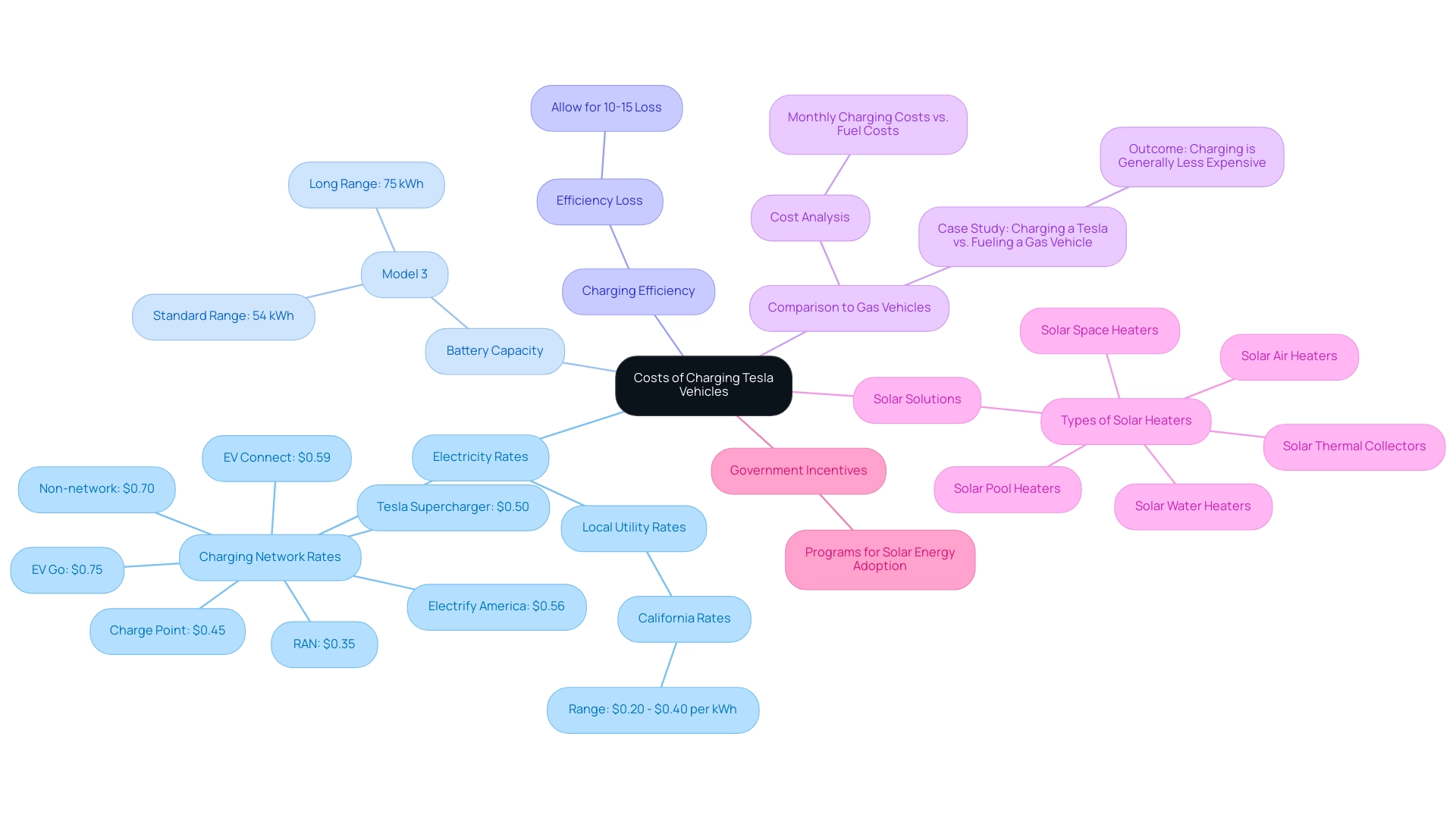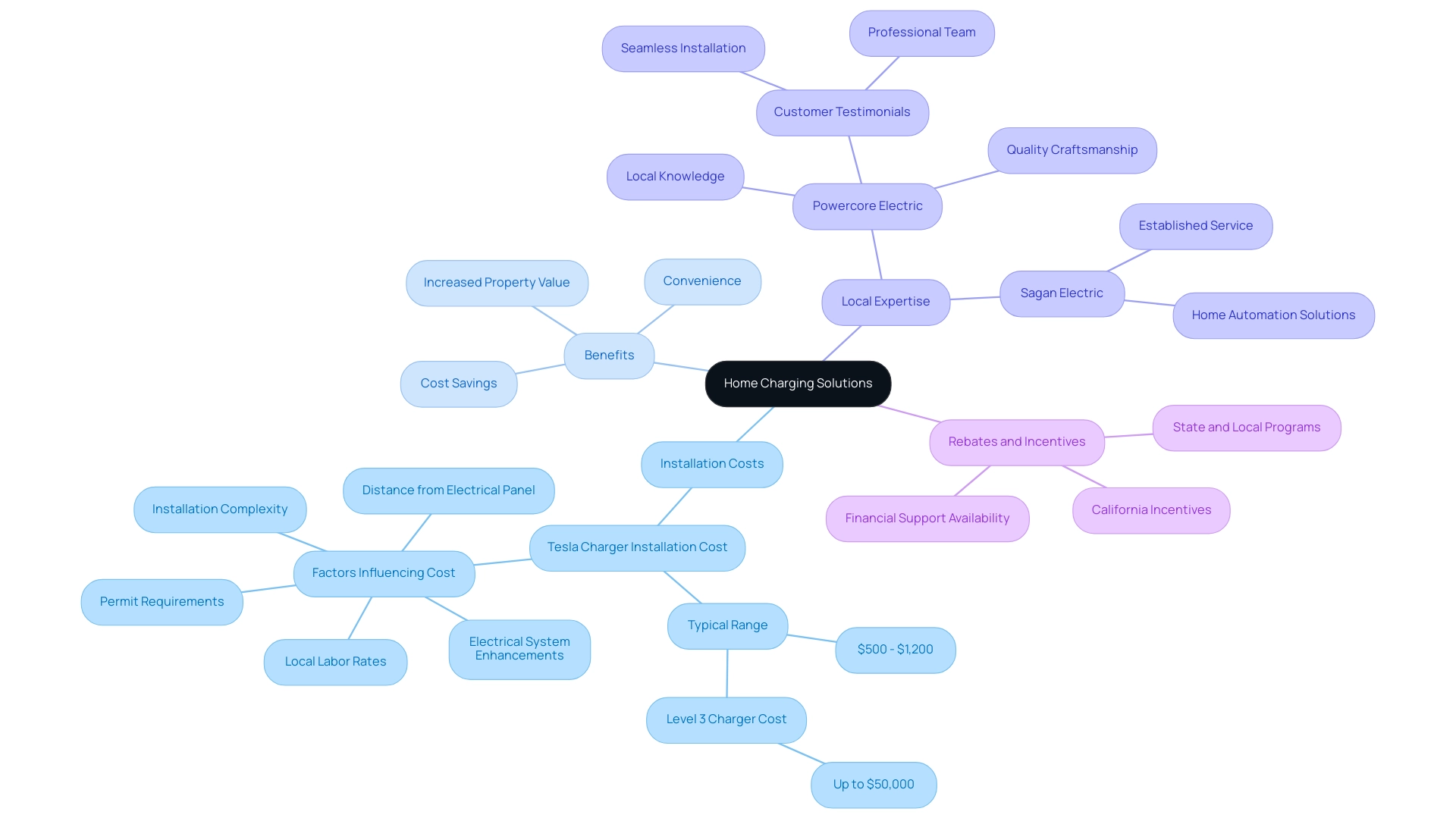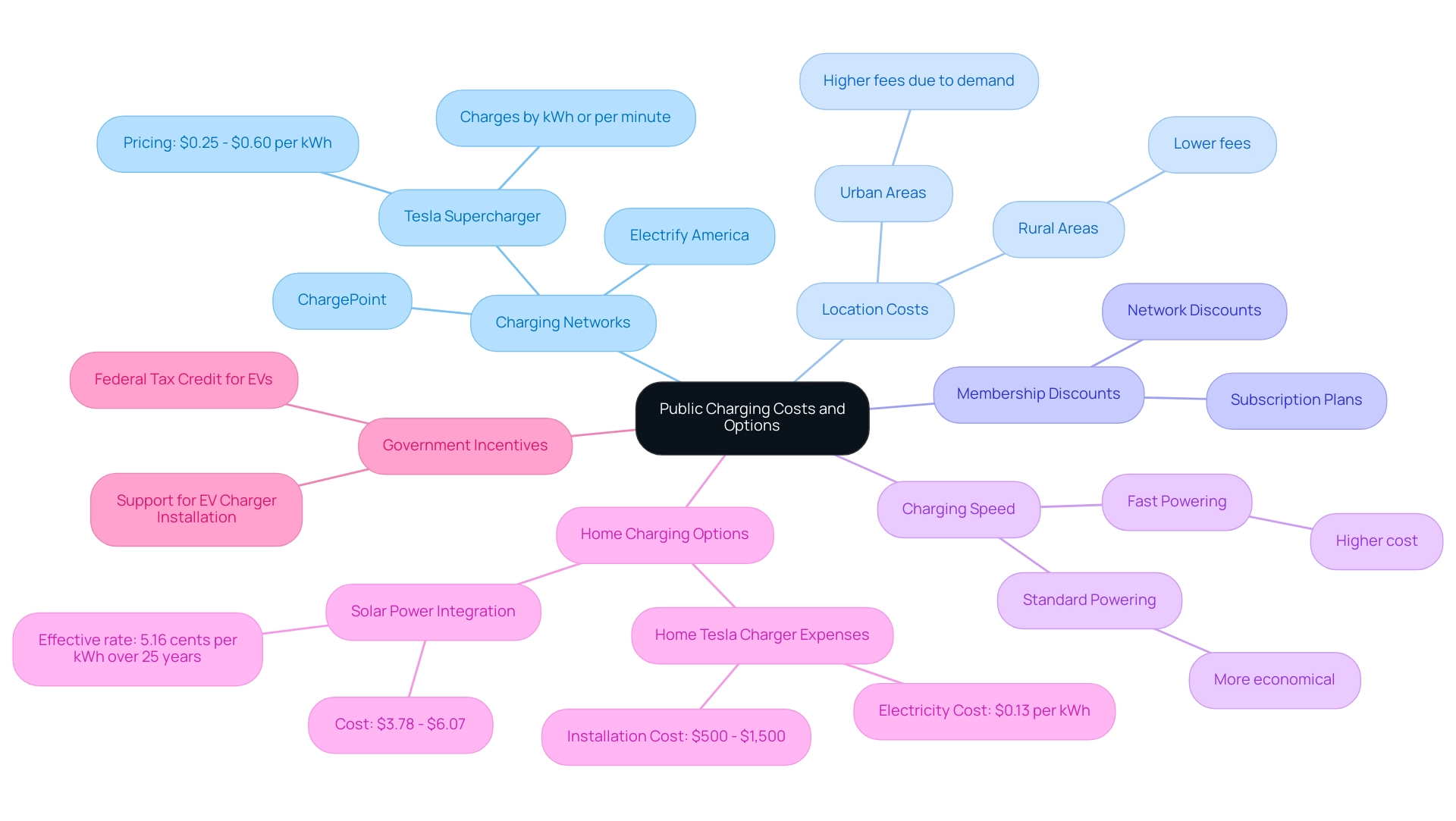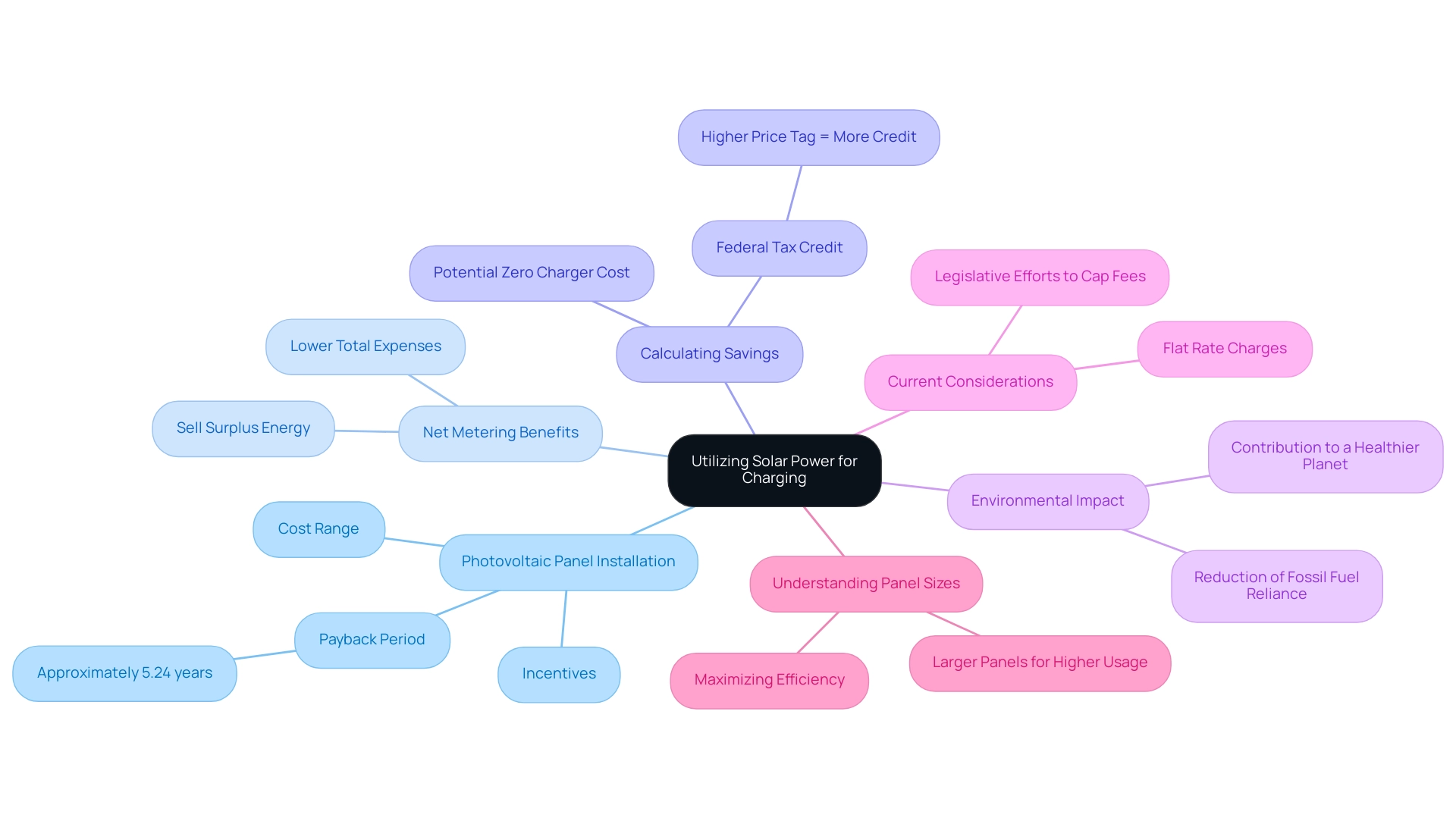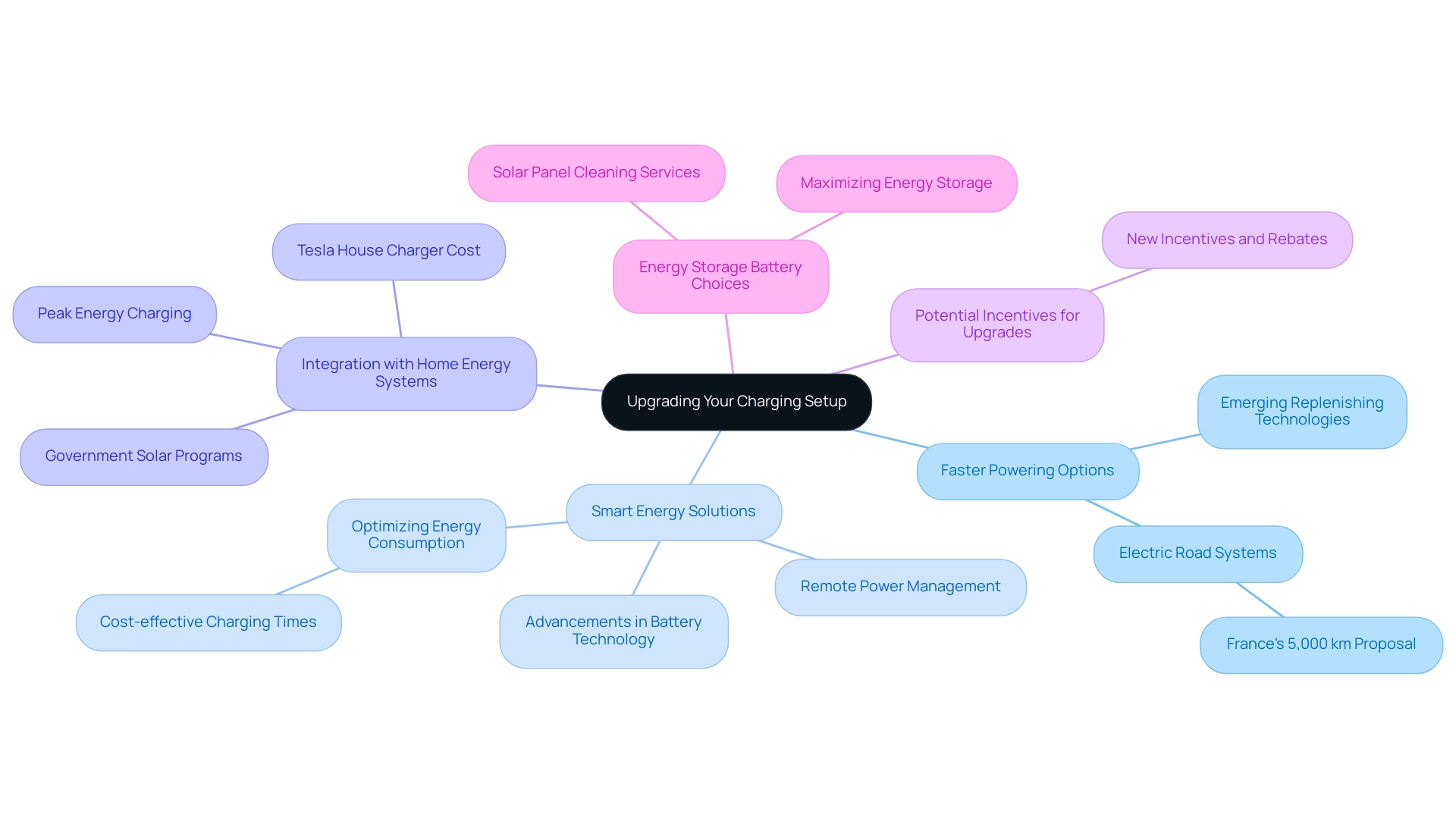Overview
The article explores the costs associated with charging Tesla vehicles at home, indicating that expenses typically range from $5 to $15 per full charge, influenced by local electricity rates, battery capacity, and charging efficiency. It underscores that investing in a home charging station not only enhances convenience but also reduces long-term expenses, particularly when combined with renewable energy sources such as solar power, which can further lower electricity costs and provide environmental benefits.
Introduction
Navigating the world of electric vehicle ownership can feel overwhelming, especially when it comes to understanding the costs associated with charging a Tesla. With factors like local electricity rates, battery capacities, and charging habits influencing expenses, it’s essential for homeowners to get a clear picture of what to expect.
This article dives into the nitty-gritty of charging costs, comparing the benefits of home installations versus public charging options, and highlights the potential savings when integrating solar power into your charging routine.
By the end, readers will be equipped with the knowledge to make informed decisions that not only save money but also contribute to a more sustainable future.
Understanding the Costs of Charging Tesla Vehicles
The expenses for Tesla vehicles can vary greatly depending on various key elements, such as your local electricity rates, the specific Tesla model you possess, and your personal power usage habits. On average, the Tesla house charger cost for charging at home can range between $5 to $15 for a full charge, whether using a standard outlet or a dedicated charger. To help you calculate your precise costs, here are some key considerations:
- Electricity Rates: Start by checking with your local utility provider to find out the cost per kilowatt-hour (kWh). For instance, in California, these rates can range from $0.20 to $0.40 per kWh. In comparison, pricing rates from various networks can vary, with Charge Point at $0.45, Electrify America at $0.56, EV Connect at $0.59, and others.
- Battery Capacity: Different models from the company come with varying battery capacities. For example, the Model 3 has a battery capacity that spans from about 54 kWh (Standard Range) to 75 kWh (Long Range).
- Charging Efficiency: Don’t forget to factor in that power transfer isn’t 100% efficient; you should allow for an extra 10-15% in your calculations.
To illustrate the financial advantages of the Tesla house charger cost for powering an electric vehicle, consider the case study titled ‘Powering an Electric Vehicle vs. Refueling a Gas Car,’ which emphasizes that using a Tesla house charger is usually more economical than gasoline. The projected monthly expenses for different electric vehicle models are considerably less than the corresponding fuel expenses, emphasizing the savings linked to electric vehicle ownership.
Furthermore, for environmentally aware residents in Long Beach, combining your electric vehicle power source with renewable energy can enhance these savings. With panel functionality, you can generate your own energy to charge your vehicle, significantly reducing your reliance on grid electricity and further lowering costs.
In addition to Tesla power supply, consider investing in solar-powered heating solutions. Here are the Top 5 Solar Powered Heaters You Need to Consider for your home:
- Solar Water Heaters
- Solar Air Heaters
- Solar Pool Heaters
- Solar Space Heaters
- Solar Thermal Collectors
Furthermore, there are government programs and incentives available that can assist you in adopting solar energy solutions, making it even more affordable to transition to renewable energy.
Now, let’s look at how to estimate your charging costs:
- If you have a Model 3 with a 75 kWh battery and you’re charging at a rate of $0.25 per kWh:
- Cost per full charge = 75 kWh * $0.25 = $18.75
- Adjusted for efficiency = $18.75 / 0.85 = roughly $22.06.
RNS, a well-known member of the community, expressed, “I could not care less, really. After driving my Tesla for a while, though, it just feels as if CCS EV owners are getting scammed and ripped off by energy providers.” This viewpoint emphasizes the importance of Tesla’s power supply in relation to other electric vehicle alternatives.
When you analyze the figures, powering your electric car at home can provide significant savings in comparison to refueling a conventional gas vehicle. Considering the present average fuel expenses, it’s evident that adopting electric vehicle ownership not only aids the environment but is also gentler on your finances, particularly when combined with solar solutions.
Home Charging Solutions: Installation Costs and Benefits
Setting up a home charging station for your electric vehicle not only enhances convenience but also aids in reducing overall charging expenses. Here’s a breakdown of the key aspects you should consider:
-
Installation Costs:
- When it comes to installing a Tesla Wall Connector, you can expect to pay between $500 and $1,200 on average. This price can vary based on installation complexity, local labor rates, and how far the charger is from your electrical panel. If enhancements to your electrical system are necessary or if local permits are required, these factors can also impact the final expense, such as the tesla house charger cost. It’s worth noting that a Level 3 home charger installation could cost up to $50,000, which emphasizes the tesla house charger cost while providing a broader perspective on power options and expenses. For the best advice, consulting a local electrician is recommended.
-
Benefits of Home Charging:
- Convenience: Imagine waking up every morning to a fully charged vehicle! With home power, you can plug in your Tesla overnight and start each day ready to go.
- Cost Savings: Typically, powering at home is more economical than utilizing public stations, particularly if you benefit from off-peak pricing. This can lead to substantial savings over time.
- Increased Property Value: Installing a home power station can enhance your property’s appeal, particularly among potential buyers interested in electric vehicles. It’s a modern upgrade that reflects growing trends in sustainable living.
-
Powercore Electric’s Local Expertise:
- As a locally-owned company, Powercore Electric understands the unique electrical needs of California communities and delivers tailored solutions that work for your specific location. Their commitment to unmatched quality craftsmanship ensures that every installation meets the highest standards of quality, safety, and efficiency, making your project their priority from start to finish. Customers have praised Powercore Electric, with one satisfied client stating, “The installation process was seamless, and the team was incredibly knowledgeable and professional!”
-
Rebates and Incentives:
- Don’t overlook the financial support available! Many states and local utilities offer rebates or incentives for installing EV charging stations. For instance, California offers various programs that can significantly lower your installation expenses. Be sure to check with your local government to see if you qualify for any assistance, which could significantly lower your installation costs.
By investing in a residential power solution, electric vehicle owners can enjoy the benefits of convenience and cost-efficiency, making the transition to electric cars even more attractive. It’s also worth mentioning that the chargers are intended specifically for these vehicles, ensuring optimal power-up rates and efficiency. As Sean Tucker, an expert in the automotive and energy sectors, puts it,
Understanding these financial benefits is crucial as the landscape of EV ownership continues to evolve.
So, why not take the plunge and improve your home with a power station?
Public Charging Costs and Options
When it comes to using public charging stations for your electric vehicle, understanding the costs can be a bit tricky, as they can fluctuate based on various factors like the network, location, and charging speed. Here’s a friendly breakdown to guide you:
- Charging Networks: Various networks, including Superchargers, ChargePoint, and Electrify America, employ their own pricing structures. For instance, Tesla Supercharger stations often charge either by the kWh or per minute of usage, with prices typically ranging from $0.25 to $0.60 per kWh.
- Location Matters: The area where you charge can significantly influence costs. Urban environments typically have higher fees for electricity compared to rural regions, mainly because of increased demand and operational costs. Checking prices in advance can help you avoid any unexpected surprises.
- Membership Discounts: If you frequently use public chargers, consider exploring subscription plans or membership discounts available through some networks. These options can help reduce your overall expenses, making it a more budget-friendly choice.
- Fast Powering vs. Standard Powering: While fast powering saves time, it can come at a higher price. Standard power supply is generally more economical and works well when you can leave your car parked for longer, such as at your local shopping mall or workplace.
- Powering Efficiency: Keep in mind that powering efficiency varies by charger type. Level 3 chargers often exceed 90 percent efficiency, while Level 1 or Level 2 chargers typically reach about 85 percent. This variation can affect your total expenses and duration.
As Austin, a lithium expert, puts it, “Charging at home is king!” This sentiment rings especially true for those enrolled in programs like Duke’s $20/month test plan for unlimited power options, leading to considerable savings.
- Home Tesla Charger Expenses: For homeowners considering a home Tesla charger, the tesla house charger cost for installation typically ranges from $500 to $1,500, depending on factors such as electrical upgrades and labor. Additionally, the average price of electricity for charging at home is around $0.13 per kWh, which can lead to significant savings compared to public charging.
- Government Incentives: Homeowners may also benefit from government programs and incentives that support the installation of EV chargers and renewable energy systems. Programs such as the Federal Tax Credit for Electric Vehicles can help reduce installation expenses, making it a more viable option for many.
- Home Charging: Also, consider the advantages of integrating a home power system. A case study demonstrates that using sunlight can lower your expenses to between $3.78 and $6.07, which is considerably more affordable than conventional grid electricity prices.
Over 25 years, investing in a photovoltaic system can yield an effective rate of approximately 5.16 cents per kWh of electricity generated from sunlight.
By considering these elements, you can make knowledgeable choices regarding public power sources and utilize the advantages of renewable energy, aiding you in managing expenses efficiently while enjoying your journey towards a more sustainable future.
Utilizing Solar Power for Charging
Incorporating renewable energy into your home charging system is an excellent method to adopt sustainability while also reducing your Tesla house charger cost significantly. Here’s a closer look at how this works:
- Photovoltaic Panel Installation: By installing photovoltaic panels, you can generate the energy necessary to charge your Tesla, often leading to significantly lower or even zero electricity bills. In California, the average cost for a residential installation of renewable energy systems ranges from $15,000 to $30,000, but thanks to local incentives and government programs, these costs can be significantly offset. Programs under the 200% rule enable homeowners to produce more energy than they use, making this energy source a wise investment with a payback period of approximately 5.24 years—a viable financial decision for many homeowners.
- Net Metering Benefits: One of the standout features of photovoltaic systems is net metering. If your photovoltaic panels generate more energy than you use, this system enables you to sell that surplus energy back to the grid, further lowering your total expenses. This indicates you could not only reduce expenses on electricity but potentially earn credits on your electric bill as well.
- Calculating Savings: Picture merging renewable energy with your Tesla power requirements—this can result in remarkable savings. For instance, if your energy system generates enough power to meet all your charging needs, you could observe the Tesla house charger cost decrease to nothing. This is not just a theoretical scenario; many homeowners are already experiencing these benefits. As Emily Walker noted, ‘The higher the price tag, though, the more you’ll get back as a credit towards your federal tax bill,’ highlighting the financial advantages of investing in renewable energy.
- Environmental Impact: Charging your Tesla with renewable energy goes beyond savings; it’s about making a positive impact on the environment. By reducing your reliance on fossil fuels, you contribute to a healthier planet and align your lifestyle with your eco-conscious values. Government programs for renewable energy can further assist homeowners in financing their installations, making it easier to adopt sustainable practices.
- Current Considerations: It’s important to be aware of the changing environment of renewable energy in California. Recently, regulators permitted utility companies to impose a flat rate charge on all electric bills, including those of renewable energy customers whose bills would otherwise be zero. This new fee is seen as a disincentive for residential energy adoption, prompting legislative efforts to cap the fee. Such developments indicate ongoing volatility in California’s renewable energy policy and should be considered when investing in this energy sector.
- Understanding Panel Sizes: Selecting the appropriate dimensions for your panels is essential for fulfilling your energy requirements. Larger panels can produce more electricity, which is especially advantageous for homeowners with greater energy usage, such as those powering electric vehicles like Teslas. Understanding your energy needs and choosing appropriately sized panels can maximize the efficiency of your energy system.
Investing in renewable energy for your power requirements is a beneficial scenario. It provides both financial benefits and a dedication to environmental stewardship, making it an attractive option for vehicle owners who wish to optimize their investment.
Future Considerations: Upgrading Your Charging Setup
As the world of electric vehicle technology advances, Tesla owners have a fantastic opportunity to improve their power setups with future upgrades in the context of the burgeoning solar energy landscape. Here are some key advancements to keep an eye on:
-
Faster Powering Options:
Exciting new replenishing technologies are emerging that promise to significantly reduce filling times.
By ensuring your home power station is equipped with the latest innovations, you can minimize downtime and enjoy more time on the road. Notably, as countries explore expanding Electric Road systems to support EV infrastructure, the benefits for Tesla owners are immense.
-
Smart Energy Solutions:
The emergence of intelligent power systems is changing how we handle our energy usage.
These systems allow you to observe and manage your power usage remotely, optimizing energy consumption and expenses based on your preferences and current utility rates. Imagine being able to begin powering your Tesla at the most cost-effective times without lifting a finger! Advancements in battery technology will also play a crucial role in enhancing these smart charging solutions, making them even more efficient.
-
Integration with Home Energy Systems:
Future developments may lead to even better integration with home energy management systems. This implies you could strategically charge your vehicle when energy production is at its peak, maximizing your eco-friendly energy use. It’s a win-win for both the environment and your wallet!
Homeowners can benefit from government programs that support solar energy, making this integration more accessible. Additionally, understanding the Tesla house charger cost can help you evaluate the overall cost-effectiveness of these upgrades.
Potential Incentives for Upgrades:
As the electric vehicle market develops, new incentives and rebates are likely to arise for enhancing your current infrastructure. This could make it more affordable to keep your setup aligned with advancements in technology, ensuring you always have the best power experience.
Energy Storage Battery Choices and Cleaning Services:
Considering energy storage battery options is vital for maximizing energy storage and efficiency. Additionally, utilizing top solar panel cleaning services can ensure your solar system operates at peak performance, further enhancing your energy savings.
By looking ahead and planning for these upgrades in the context of solar energy solutions, Tesla owners can maintain an efficient and cost-effective charging setup, which includes understanding the Tesla house charger cost, staying ahead in the rapidly evolving landscape of electric vehicle technology.
It’s all about making your journey smoother and more sustainable!
Conclusion
Understanding the costs associated with charging a Tesla is crucial for any homeowner venturing into electric vehicle ownership. By considering factors such as local electricity rates, battery capacities, and charging habits, it’s possible to gain a clearer picture of potential expenses. Charging at home typically offers a more economical option, especially when compared to public charging, which can vary widely in cost. The investment in a home charging station not only enhances convenience but also contributes to long-term savings.
Incorporating solar power into your charging routine can further amplify these benefits. By generating your own energy, homeowners can significantly reduce or even eliminate their charging costs, all while making a positive impact on the environment. With the right setup, including solar panels and possibly even battery storage, the financial and ecological advantages become even more pronounced.
As technology continues to evolve, staying informed about future upgrades and innovations in charging solutions will empower Tesla owners to optimize their experience. Embracing these advancements not only enhances personal convenience but also aligns with a broader commitment to sustainability. By making informed choices today, homeowners can pave the way for a more efficient and eco-friendly driving experience, ensuring that the journey towards a greener future is both practical and rewarding.

